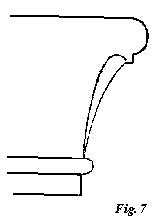CONSTRUCTION VI. THE WALL CORNICE 97
approximation to the shape of a falcon’s beak, and often reaching it completely. But the essential part of the arrangement is the up and under cutting of the curve. Wherever we find this, we are sure  that the climate is wet, or that the builders have been bred in a wet country, and that the rest of the building will be prepared for rough weather. The up cutting of the curve is sometimes all the distinction between the mouldings of far-distant countries and utterly strange nations. Fig. 7 represents a moulding with an outer and inner curve, the latter under-cut. Take the outer line, and this moulding is one constant in Venice, in architecture traceable to Arabian types, and chiefly to the early mosques of Cairo. But take the inner line; it is a dripstone at Salisbury. In that narrow interval between the curves there is, when we read it rightly, an expression of another and a mightier curve,-the orbed sweep
that the climate is wet, or that the builders have been bred in a wet country, and that the rest of the building will be prepared for rough weather. The up cutting of the curve is sometimes all the distinction between the mouldings of far-distant countries and utterly strange nations. Fig. 7 represents a moulding with an outer and inner curve, the latter under-cut. Take the outer line, and this moulding is one constant in Venice, in architecture traceable to Arabian types, and chiefly to the early mosques of Cairo. But take the inner line; it is a dripstone at Salisbury. In that narrow interval between the curves there is, when we read it rightly, an expression of another and a mightier curve,-the orbed sweep  of the earth and sea, between the desert of the Pyramids, and the green and level fields through which the clear streams of Sarum wind so slowly.
of the earth and sea, between the desert of the Pyramids, and the green and level fields through which the clear streams of Sarum wind so slowly.
And so delicate is the test, that though pure cornices are often found in the North,-borrowed from classical models,-so surely as we find a true dripstone moulding in the South, the influence of Northern builders has been at work; and this will be one of the principal evidences which I shall use in detecting Lombard influence on Arab work; for the true Byzantine and Arab mouldings are all open to the sky and light, but the Lombards brought with them from the North the fear
IX. G
[Version 0.04: March 2008]

